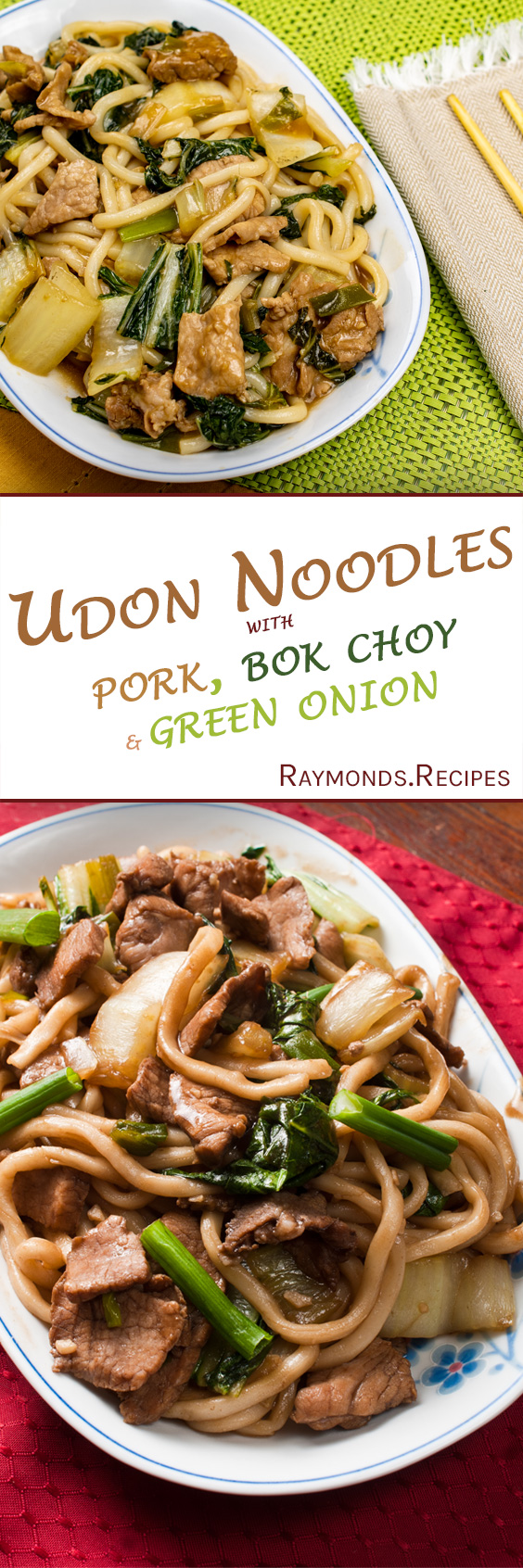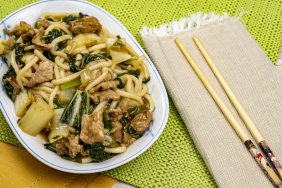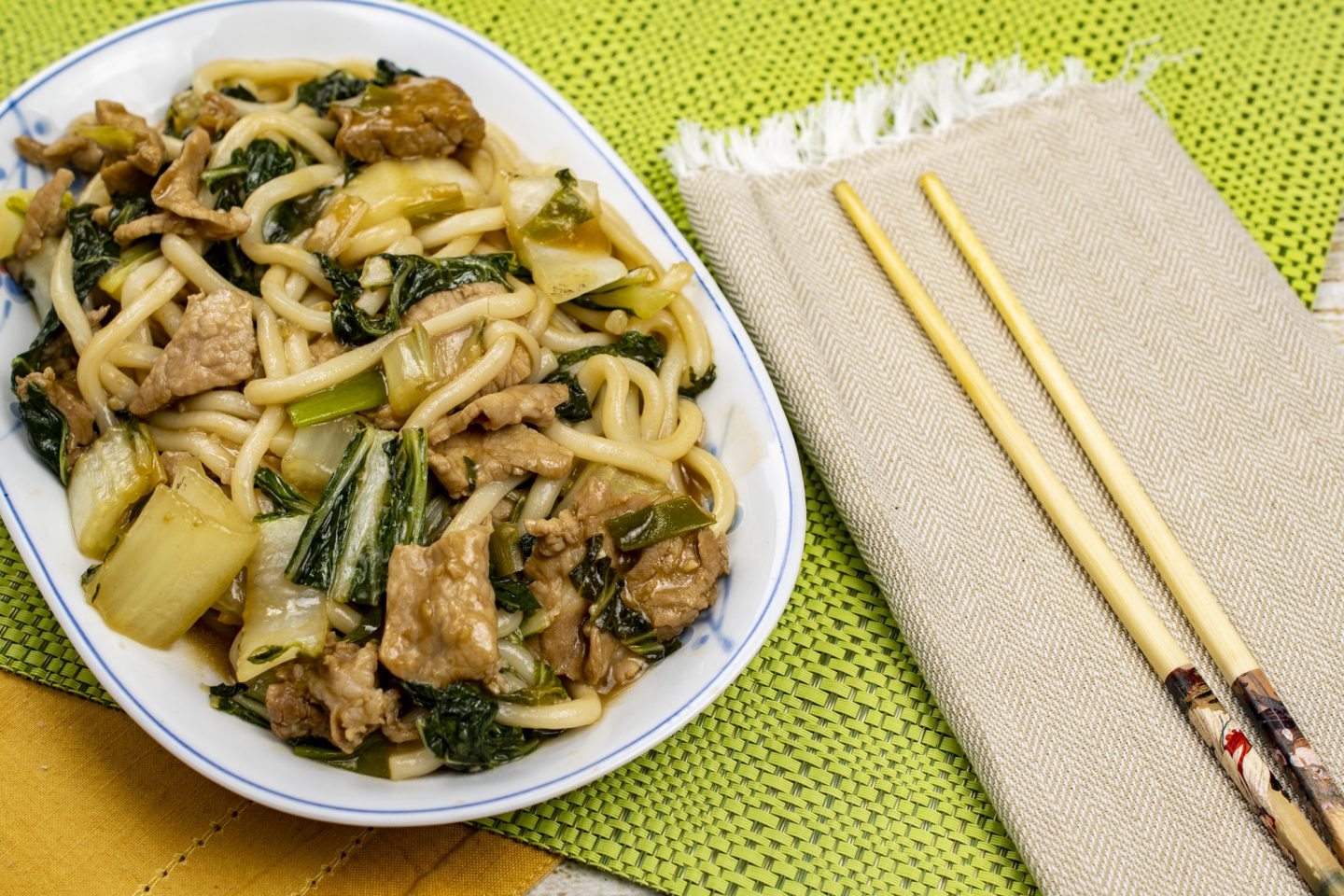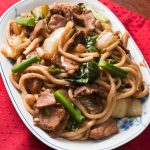Udon Noodles with shaved pork, bok choy and green onion


I was looking to revamp my Shanghai Noodle recipe, but due to low stock of Napa cabbage and shanghai noodles at my local No Frills and the fact that I so rarely use dark soy sauce as to never have it on hand, I got this dish instead.
Bok choy has such a wonderful flavour which nappa cabbage lacks. It really changes this into its own unique dish instead of just being “almost Shanghai noodles” .
A Comprehensive Guide to Ramen and Udon: What’s the Difference, What to Order and More
What are the Differences Between Ramen and Udon?
Ramen and Udon are both types of noodle that are popular in Japan. However, they have a few differences. Ramen is made with wheat Noodles and is served in a clear broth. Udon on the other hand is made with white wheat flour Noodles and served in a thick broth.
The most important difference between Ramen and Udon is that Ramen can be eaten without any toppings or garnishes, while Udon requires additional toppings such as tempura or boiled egg to make it more filling.
Ramen and Udon are both noodles in soup. They are very similar to each other, but there are some differences. Ramen is thicker and chewier than Udon because it has more flour in it.
Ramen is often served with a flavored broth, while Udon is more commonly served with a clear broth.
Ramen and Udon are two types of noodle Soup that are often confused with one another. This article will go over the differences, what to order, and more.
Ramen is a Japanese dish consisting of wheat noodles served in a meat or fish-based broth, often flavored with soy sauce or miso and uses toppings such as sliced pork (chasu), dried seaweed (nori), boiled egg (tamago), and green onions.
Udon is also a Japanese dish consisting of wheat noodles served in a meat or fish-based broth, but it does not use soy sauce or miso as flavoring agents. It does use toppings such as sliced pork (chasu), dried seaweed (nori), boiled egg (tamago) and green onions.
Similarities Between Ramen and Udon?
Ramen and Udon are two different types of noodles that are popular in Japan. They are both made from wheat flour, water, salt, and sometimes eggs. The Main difference between these two noodles is the thickness of the noodles. Udon is much thicker than Ramen so it has a chewier texture.
Ramen is made with wheat flour and salt while udon is made with wheat flour, salt, and kansui (a type of alkaline water).
Ramen usually has a soup base while udon broth is usually clear.
Ramen toppings are usually pork or beef-based while udon toppings are often seafood-based.
The main difference between ramen and udon is the thickness of the noodle. ramen noodles are typically thin and straight, while udon noodles are thick and curly. The other difference is the cooking technique – udon noodles are boiled in water until they’re soft, then rinsed with cold water to stop them from cooking any further; while ramen has to be cooked for a long time in boiling water before being added to the soup at the end of cooking time.
The Complete Guide to Shaved Pork and How It’s Shaping the Future of Food
Introduction: What is Shaved Pork?
Shaved pork is a new food concept that has been gaining popularity in the recent years. It’s a type of pork that is taken from the belly of the pig and chopped into thin slices.
This article talks about how shaved pork is shaping the future of food and what it means for people who want to eat healthier.
The Complete Guide to Shaved pork and How It’s Shaping the Future of Food
Shaved pork, also known as Pork Belly, is a new food concept that has been gaining popularity in recent years. Shaved pork is a type of pork that has been taken from the belly of the pig and chopped into thin slices. This article will discuss how this new meat trend shapes the future of food, what it means for people who want to eat healthier, and more!
Shaved pork is a type of pork that has been shaved into thin, long strips. It is often used in dishes like ramen or as a topping for sandwiches.
In the U.S., you can find this type of food at Korean restaurants, but it’s not as popular as other types of pork. It’s usually made from pork belly and then shaved to create thin pieces that are crispy on the outside and tender on the inside.
In Korea, shavings are eaten as a Snack or added to soups and other dishes. The main use for this type of meat is in ramen noodles, which is why it’s sometimes called “ramen bacon“.
Shaved pork is a type of meat that is shaved into thin slices. It is often served as a Condiment or topping on dishes such as pizza, sandwiches, and tacos.
It can be made from any type of meat, but pork belly is the most popular choice. Pork rinds are also shaved into thin slices and they are both used in similar ways.
Shaved pork has been around for centuries and it has only become more popular in recent years. It has been gaining popularity because it’s low cost, easy to make, and versatile.
What Makes Shaved Pork Unique and Special?
Shaved pork is a type of pork and bacon product that’s very popular in the United States. It’s made by cutting a slab of meat into thin slices, then cooking it. Shaved pork is often used as a topping for sandwiches and tacos, or as an ingredient in salads.
The difference between bacon bits and shaved pork is that the latter is made from skinless ribs or loin, while bacon bits are made from any cut of meat.
Shaved pork is a type of meat that has become very popular in recent years. It is made from the rib section of the pig and has a distinctive, thin and translucent appearance. The most notable difference between bacon bits and shaved pork is that bacon bits are not as thinly sliced as shaved pork.
The popularity of this type of meat has been increasing for some time now. This can be seen in the increase in restaurants that offer it on their menus, grocery stores stocking it, and even TV shows featuring it. Shaved pork has many benefits over other types of meat such as bacon bits or Ham because it contains less fat than both but still maintains a similar flavor profile to those meats.
Shaved pork is a new type of food that has been around for about 10 years but has recently gained popularity. It is made from thin slices of pork, which are cooked and served like bacon bits. Shaved pork can be used as an Appetizer or Side Dish.
Benefits of Shaved Pork:
- It is crispy and crunchy
- It is lower in fat than bacon
- It contains less sodium than bacon
- You can use it as an appetizer or side dish.
Ingredients
- 1/3 cup soy sauce
- 1/4 cup oyster sauce
- 1 1/2 tbsps ginger minced fresh
- 3 cloves garlic chopped
- 2 tbsps sugar
- 1 cup chicken broth
- 1 tbsp corn starch or flour
- 1 1/2 lbs Pork Loin shaved
- 1 bok choy medium, or 1-2 bundles of baby bok choy
- 1 green onion bundle
- 400 g udon noodles pre-cooked
- 1 tbsp sesame oil optional
- 1 tbsp rice vinegar optional
Instructions
- In a medium mixing bowl whisk together the soy sauce, oyster sauce, ginger and sugar. Whisk until sugar is completely dissolved.
- Whisk together the chicken broth and corn starch / flour and set aside
- Place the pork in a ziplock back, cover with marinade, press out the air from the bag, seal and massage to coat the meat. Roll the bag up tight and place in the fridge at least 10 mins.
- In the mean time, chop your veggies. Chop the stalks of the green onions into 2″ long pieces and the stalks of the bok choy into 3/4″ – 1″ pieces and set aside together.
- Chop the leaves of both the bok choy and the onions into about 1 1/2″ – 2″ pieces- they’re gonna shrink drastically in the pan so you still want big mouthfuls of them!
- Set a pot of water to boil, but don’t add the udon noodles yet.
- In a large, deep pan or wok heat vegetable oil on high. Add the meat with all its marinade and stir fry til most pieces are mostly brown (1-3 mins). It's fine if they're still a little pink in the center, they'll finish cooking in the sauce and come out just right. Remove the meat and set aside, leaving the sauce.
- Add the bok choy and onion stalks with the garlic to the pan and stir fry til they soften (about 30-60 seconds).
- Return the meat to the pan along with vegetable leaves and chicken broth. Toss thoroughly.
- Add the udon noodles to the boiling water and break apart with fork, cooking to just before package directions, strain then add to the pan / wok and toss some more to thoroughly coat with sauce. Then serve!
- Optionally drizzle in sesame oil and white rice vinegar and toss some more right before serving.
Nutrition






